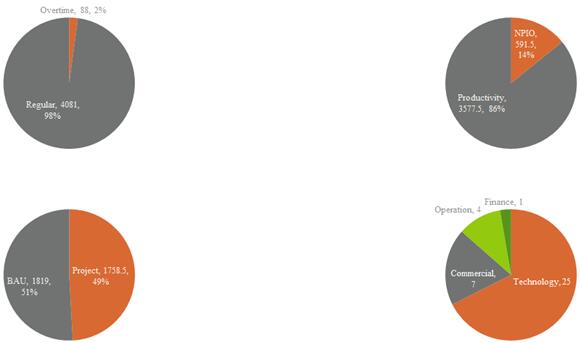,這些分析和規劃工具為整個團隊提供了有效決策的信息。同時,這也幫助PMO能夠集中精力在數據的處理和分析,而不是數據的收集和驗證。
圖7 PPM工具提供給部門領導的控制臺
4.8 回顧
建立項目管理辦公室是一項新的部門挑戰(Isola et al., 2006)。PMO通過在不同維度展開各種工作來嘗試給團隊帶來積極影響,通過行為改變來為團隊的項目和項目集管理帶來關鍵的規范和流程。部門負責人堅定不移的支持和承諾對這一轉變取得成功至關重要。此外,PMO必須抓住每一個機會來對管理流程持續改進,在項目生命周期早期確定并減輕風險,并確保最佳實踐和經驗教訓能夠被每一個項目吸收(Singh et al., 2009)。PMO全生命周期流程如表1所示。
表1 PMO全生命周期流程總覽
項目管理辦公室的下一步工作還是圍繞著對項目進度、預算和交付的控制展開工作,來協助部門和下屬團隊成為一個更有成效和更有效的組織。通過行之有效的計劃,PMO將設定符合現實的期望, 最終提高業務部門的滿意度。
5. 總結
項目管理辦公室通常受組織變化而被動變化,這也導致PMO的的平均穩定發展時間少于4年(Hobbs and Aubry, 2007)。Pellegrinelli和Garagna(2009)形容“PMO通常成為個人與流程,以及不同組織派系之間爭奪權力和控制的競技場”。這樣的觀察表明,PMO的關閉可能不是單純績效低下而帶來的自然消亡,而更像一種組織戰略調整的附帶損害。他們同時指出,PMO需要不斷地針對快速變化的組織需求和利益干系人的控制缺失而制定相應的流程管理。
為了提高項目管理辦公室實現持續發展的可能性,所屬的組織應當(1)重點關注項目執行效益、建立項目狀態匯報并推進項目管理標準,(2)積極引導項目規劃,實現項目組合管理,并進一步建立基于組織戰略的項目甄別機制,(3)建立并運行一套項目管理的信息庫,以支持項目經驗教訓在組織內的有效分享,(4)設定組織內項目管理職業規劃,建立以項目管理作為組織能力的管理體系。
每一個項目管理辦公室都沿著各自設定的線路前進,它的功能和職責隨其所在的組織一起發展壯大。PMO 很少能滿足組織的所有要求,因此需要針對每一個組織目標設定精確的目標予以實現。為了給組織帶來成功,PMO不僅需要成為優秀的戰術執行人保障組織的項目交付,更需要將自己轉變為組織戰略的思想者和推動者。
參考文獻
Aubry, M., Hobbs, B. and Thuillier, D. (2008) 'Organisational project management: An historical approach to the study of PMOs', International Journal of Project Management, 26(1), pp. 38-43.
Benson, L. R. (2008) Acquisition management in the US Air Force and its predecessors. DIANE Publishing.
Bossidy, L., Charan, R. and Burck, C. (2002) Execution: the discipline of getting things done. London: Random House Business.
Bresnen, M., Goussevskaia, A. and Swan, J. (2005) 'Organizational routines, situated learning and processes of change in project-based organizations', Project Management Journal, 36(3), pp. 27.
Buttrick, R. (2009) The project workout: the ultimate handbook of project and programme management. 4th edn. Harlow: Financial Times Prentice Hall.
Christiansen, J. C. and Sherry, T. C. (1992) 'Project management oversight: a partnership in mass transit projects', AACE International Transactions, 2, pp. M. 4.1.
Crawford, J. K. (2010) The strategic project office. CRC Press.
Czuchry, A. J. and Yasin, M. M. (2003) 'Managing the project management process', Industrial Management & Data Systems, 103(1), pp. 39-46.
Dai, C. X. and Wells, W. G. (2004) 'An exploration of project management office features and their relationship to project performance', International Journal of Project Management, 22(7), pp. 523-532.
Desouza, K. C. and Evaristo, J. R. (2006) 'Project management offices: A case of knowledge-based archetypes', International Journal of Information Management, 26(5), pp. 414-423.
Dey, P. K., Kinch, J. and Ogunlana, S. O. (2007) 'Managing risk in software development projects: a case study', Industrial Management & Data Systems, 107(2), pp. 284-303.
Englund, R. L., Graham, R. J. and Dinsmore, P. C. (2003) Creating the project office: A manager's guide to leading organizational change. John Wiley & Sons.
Faisal, M. N., Banwet, D. and Shankar, R. (2007) 'Supply chain risk management in SMEs: analysing the barriers', International Journal of Management and Enterprise Development, 4(5), pp. 588-607.
Gulledge, T. (2006) 'What is integration?', Industrial Management & Data Systems, 106(1), pp. 5-20.
Hill, G. M. (2004) 'Evolving the Project Management Office: A Competency Continuum', Information Systems Management, 21(4), pp. 45-51.
Hobbs, B. and Aubry, M. (2007) 'A MULTI-PHASE RESEARCH PROGRAM INVESTIGATING PROJECT MANAGEMENT OFFICES (PMOs): THE RESULTS OF PHASE 1', Project Management Journal, 38(1), pp. 74.
Hobbs, B. and Aubry, M. 'What Research is Telling Us about PMOs'. PMI® Global Congress 2009, Amsterdam, North Holland, The Netherlands: Project Management Institute.
Hobbs, B., Aubry, M. and Thuillier, D. (2008) 'The project management office as an organisational innovation', International Journal of Project Management, 26(5), pp. 547-555.
Isola, M., Polikaitis, A. and Laureto, R. A. (2006) 'Implementation of a Project Management Office (PMO): Experiences from Year 1', Journal of Healthcare Information Management, 20(1), pp. 79.
Julian, J. (2008) 'How project management office leaders facilitate cross‐






